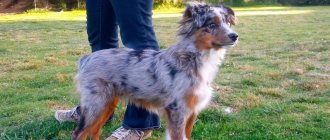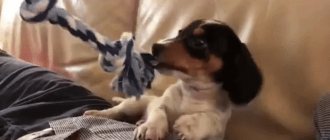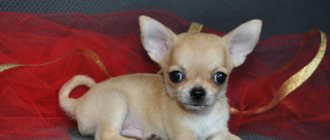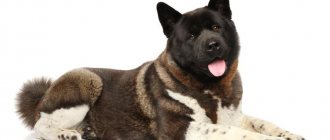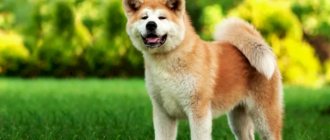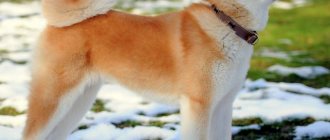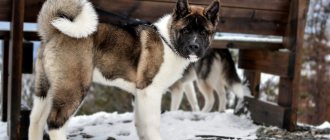- Australian Shepherd
Australian Shepherds are intelligent and active dogs with a herding instinct. Today they are ideal companion dogs with a lot of energy. They are able to work all day next to their owner. They are active and attentive. They have a balanced and friendly character. They behave very reservedly towards strangers, but do not show aggression. Good for sport and an excellent family dog.
- Country of Origin : USA
- Height at withers : male 51-58 cm, female – 46-54 cm
- Weight : male – 25-32 kg, female – 16-25 kg
- Lifespan : 12-15 years
- Use : Companion Dog, Cattle Dog
- Other names : Aussie, Australian Cattle Dog
Purchasing an Australian Shepherd puppy is a responsible and important step that you need to think carefully about before you do it. This is especially true for those people who are going to become truly responsible dog breeders. The question of choice should be approached carefully and without haste, comparing your own habits, daily routine and the nature of the chosen breed. When the future owner has decided on the breed, a new dilemma arises: how to find a bona fide breeder? Here you need to be extremely careful not to become a prematurely disappointed dog owner.
Buying an Australian Shepherd puppy is a very exciting event, because you can say that a new family member will appear. To ensure that the event does not overshadow anything, it is worth taking a responsible approach to choosing a breeder. There are no bad dog breeds; you can simply run into an unscrupulous breeder for whom money comes first. The future owner is at great risk of buying an animal that has a lot of health problems. It is for this reason that you need, first of all, to get to know the breeder well, read reviews about him and the like.
History of the Australian Shepherd breed
Despite the fact that more than half a century has been devoted to the study of the Australian Shepherd, experts have still not reached a consensus on its origin. It is believed that the breed was developed in the USA, but the history of the appearance of Aussies still goes back to Australia and is associated with the name of Eliza Forlong, the founder of Merino breeding and the production of high-quality wool on the southern continent.
Australian Shepherd
In the thirties of the 19th century, she and her family settled near Campbell Town, a small town in the east of Tasmania (Australia), where she emigrated from Scotland with her husband and two sons. Here the family founded the Winton farm, where they began to raise sheep purchased in Germany and brought with them. Josef Pabts was hired as a caretaker of the flocks, who followed the Forlongs along with their herding dogs - Tigers, which are now called old German shepherds. This is a confirmed version of how the ancestors of the Aussies ended up in the “Upside Down Country”.
According to another theory, the ancestor of the shepherd is the Australian coolie, which is most similar to the modern Aussie. Farmers and breeders attempted to breed the ideal four-legged shepherd by crossing the Australian Kelpie and the Cattle Dog. In addition, Tigers and Border Collies took part in the creation of the breed. As a result of selection that exceeded all expectations, the ideal shepherd dog was obtained. The animal had strength and endurance, and was able to independently assess the situation during its work and make decisions without waiting for instructions from the owner. One of the important positive qualities of the Aussie was the lack of aggression towards livestock.
At the end of the 19th century, the intensive development of the American wool market began. The main emphasis was on Australian sheep, which were brought by ships from Australia. Along with them, they also brought a herding breed of dog, which amazed local cattle breeders with its abilities. These gifted animals quickly gained popularity in the western states, where sheep breeding was most developed.
America is the birthplace of the Australian Shepherd. The first officially registered breeder is considered to be Juanita Eli, who exported Merino sheep from Australia. Along with one batch of sheep, a shepherd arrived with a bluish dog. This was the first Australian Cattle Dog purchased by Juanita Ely, who made a huge contribution to the further development of the breed.
Aussie puppy
Australian Shepherds owe their increase in popularity among the population to Jay Sisler, a rancher in Idaho. The man was an avid participant in rodeo competitions. Usually there were shows in between. Jay Sisler entertained the crowd with performances featuring his Australian shepherds Queenie, Stubby and Shorty, which won the admiration of audiences not only in the United States but also in Canada. The Walt Disney Company invited furry artists to participate in the filming of two films. All this greatly contributed to the popularization of the Aussie breed, since many wanted to get such a smart and cute four-legged friend.
The history of the development of the breed is also connected with three generations of American farmers - the Hartnagles. While breeding sheep, they also looked for a suitable assistant among herding dogs. Their choice fell on the Australian Shepherd, which impressed with its working qualities. By the way, two puppies – Badger and Goody, purchased from Juanita Eli – were “nephews” of Queenie, Jay Sisler’s famous dog. Goody gave rise to such famous lines as Wood and Flintridge. The Hartnagles rank alongside Juanita Ely and Jay Sisler on the list of famous Australian Shepherd breeders.
Australian Shepherds finally acquired their current appearance relatively recently - in the first half of the 20th century. In 1957, a shepherd named Panda appeared on the list of the National Herding Dog Registry with official rights. This was the first significant recognition of the Aussie as an independent breed. In 1962, the American Australian Shepherd Club was registered, although in fact it existed five years earlier. In 1970, the first nurseries were organized - Maywood and Las Rocosa, and soon their number reached twenty-six. The breed standard was first registered only in 1977. According to the official version, which has been repeatedly questioned by experts, the Australian Shepherd was bred as a result of crossing the Pyrenean Shepherd, Bernese Mountain Dog and Collie.
Australian Shepherd is black in color with black and tan markings.
Aussie merle color
History and origin of the breed
The Australian Shepherd (Aussie) is a versatile dog breed developed at the end of the 20th century. The selection involved several varieties of collies, Pyrenees Shepherds and Bernese Mountain Dogs.
Interesting fact
The Aussie's homeland is America, and they got their name because of their external resemblance to the Basque herding dogs, brought to the United States from Australia.
The breed was bred for American farmers. Animals work with sheep, cattle and poultry. In many countries they are involved in the police, border and mountain rescue services, as guides.
Aussie appearance
Australian Shepherd herding sheep
The Australian Shepherd is a medium-sized breed with gender differences in the size of individuals. The height of males ranges from 52-58 cm, in females it usually does not exceed 46-53 cm. The weight of the dog can vary from 18 to 30 kg.
The body is somewhat elongated in length, but the overall dimensions remain balanced, so that the dog does not look squat. In comparison with males, females look more elegant and graceful, but without a hint of fine bones.
Head and skull
The head is quite large, but at the same time it seems neat and light. Proportional to the body, with a slight rounding of the skull. The forehead is slightly rounded or flat. In the occipital region, the presence of a small tubercle is acceptable. The curve separating the forehead and nose is quite well defined. The line of the cranial vault is parallel to the bridge of the nose.
Muzzle
The Aussie's tapered muzzle tapers from the base to the bridge of the nose. Length – average, corresponding to the length of the posterior cranial part (or slightly shorter). The nose is pigmented depending on the base color. Black color is found in merle blue and black dogs, brown – in merle red and red dogs. At the same time, the marbled base color allows for small inclusions of pink color, provided that their total area does not exceed 25% of the entire nose in dogs one year and older.
Australian Shepherd puppy with blue eyes
Ears
The ears are of medium length and have a triangular shape with slightly rounded tips. Most often, a high location is noted (but not too far), but a lateral position is also acceptable, provided the following condition is met: the tip of the ear is “broken” and looks forward. The ears are semi-erect and raised when alert. Prick ears or completely drooping ears are considered a serious fault. They don't stop.
Eyes
The Aussie's gaze is very expressive and intelligent. They will carefully examine the stranger, but a certain wariness in their gaze is almost always accompanied by friendliness. The eyes have an almond-shaped cut, set moderately obliquely, not too deep, but not bulging either. There are different colors of the iris: amber, blue, greenish, brown. There may be some marbling in its color interspersed with various colors. There are even individuals with different eye colors, which is not a disqualifying fault. Black and merle-colored dogs usually have black rims around their eyes. Reds and marbled reds have a brown edging.
Jaws and teeth
I want to play
Aussies have strong jaws and a scissor bite (a pincer bite is also acceptable). Overshot and underbite of more than 3 mm are considered disqualifying faults. The teeth are strong, white, and presented as a complete set. The complete formula has 42 teeth, of which 20 are located on the upper jaw, and 22 on the lower jaw. All teeth must be present, but the absence of some due to injury will not be punished by a reduction in the score at exhibitions.
Neck
The Australian Shepherd's neck is of moderate length and has a slight bend at the nape. Strong, muscular, well set on the shoulders.
Frame
A strong body has developed muscles. The back is wide, in a natural dog stance it has a straight top line from the withers to the pelvis, continuing further into a slightly sloping croup. The front part of the body is equal in width to the back. The moderately deep chest has a pronounced relief. Its lowest point reaches the level of the elbow joint. The long ribs have a regular oval shape. The belly is tucked in, with a moderate curve from the chest to the groin.
Tail
Puppy with a short tail
The Australian Shepherd has three possible tail lengths: long, naturally short up to 10 cm long (when the puppy is born with an already short tail) and docked. When docking the tail (unless prohibited by the laws of the country) of an adult, it should also not exceed 10 cm.
Forelegs
The flat shoulder blades of the Aussie are distinguished by their close location to the withers. Their tilt angle is 45 degrees. The humerus corresponds in length to the scapula and is located at right angles to its axis. Strong paws are more reminiscent of an oval in cross-section than a circle. The elbow joint occupies a mid-position between the ground and the withers of the animal. The forearms are positioned perpendicular to the surface on which the dog is moving. The pasterns are of medium length and slightly inclined. The fifth (dewclaw) toes are removed at the owner's request. Oval feet end in curved and compactly gathered toes. The paw pads are elastic and have thick skin.
Hind limbs
The angle between the femur and the axis of the pelvis forms a perpendicular. The knee joints are clearly defined, and in the hock area the limbs are moderately curved. When looking at an Australian Shepherd from behind, its shins will be perpendicular to the ground and parallel to each other. They turn into short metatarsals. Normally, the posterior dewclaws are absent. Oval feet are compact, have curved toes that end in thick, elastic pads.
Movement style
Two handsome men
Aussie movements are smooth; characterized by speed, lightness and freedom. Despite her swing, her stride is well balanced. Both pairs of limbs move parallel to the central axis of the body. The dog's paws move closer to the projection of its center of gravity when the animal accelerates its pace. The line of the back remains straight while running. The Australian Shepherd, which has extraordinary agility, has the ability to quickly change direction and manner of movement.
Coat
The Australian Shepherd's coat is coarse, of medium length and of moderate density. Can be straight or slightly wavy. The coat consists of a longer outer coat and a short soft undercoat, which is completely replaced twice a year. Its density is directly dependent on climate conditions: the cooler it is, the higher the density of the undercoat. During the periods between changes of undercoat, moderate shedding is observed.
The head, ears, forelimbs, and areas under the hocks are covered with short, smooth hair. On the back surfaces of the forelimbs and on the buttocks, the hair forms so-called feathers - longer in the area of the hind limbs. Shepherd dogs have a moderately developed mane and collar, which are more pronounced in males.
Color
Despite the fact that among Australian Shepherds there are individuals with a variety of colors, and the breed itself is famous for its uniqueness, only four types of color are recognized as the official standard: black, marbled blue (Aussie is most often associated with it), red and marbled red.
In all cases, the presence of white areas is acceptable, but without excess. Please note that the eyes should be framed by color. As they get older, the fur darkens a little. There are also sable, graphite, golden and brindle colors, but they are not officially recognized.
Rock defects
Almost any deviations from the above standard can be considered rock defects. The most serious and common shortcomings include:
- hanging or fully erect ears;
- atypical coat.
Disqualifying faults are:
- behavioral deviations manifested by timidity or excessive aggression;
- deviations in the bite in the form of underbite or overbite of more than 3 mm (non-closure of the incisors due to their shortness is not regarded as malocclusion);
- incomplete dental formula (their loss as a result of injury is not taken into account);
- white points on the back in the space between the base of the tail and the withers, as well as on the lateral surfaces between the limbs;
- undescended testicles into the scrotum (cryptorchidism).
Breed standard
Since mini Australian shepherds are recognized mainly in the USA, the breed standard is dictated by the American MASCUSA Club.
The height of a mini Aussie is up to 45 cm (at the same time, standard Australian Shepherd dogs grow up to 58 cm, and the dwarf (toy) variety grows up to 33 cm). Weight – from 15 to 18 kg, the main condition is that the body proportions, regardless of the weight/height ratio, must be harmonious. Life expectancy is up to 13 years.
Variegated, unusual and intricate coat colors are prized. There are black, red shades or red and blue merle. White spots are allowed on the head, neck and paws. Most often in the photo you can see Aussies with tricolor wool. The coat is long or medium length. The coat is two-layered: guard hair and dense dense undercoat.
The tail is allowed to be docked after birth, but the world canine community is already trying to refuse docking of tails and ears, unless it is caused by medical or service indications for dogs of any breed. For standard Aussies, a docked tail was a recognizable feature.
The body is strong, toned, muscles are developed. The dog is agile, agile, agile when running, and fast. The paws are strong, the back is flat, wide, the stomach is tucked. The head is small, sometimes with a tubercle at the back of the head, the forehead is flat. The muzzle tapers closer to the nose, the bite is scissor-shaped, the teeth are white and strong. Eyes of any color, most often blue. The ears are triangular.
Photo of an adult Australian Shepherd
Australian Shepherd personality
Cheerful, affectionate, quick-witted and agile - this is how you can describe any Australian Shepherd. By the way, this is one of the few breeds whose representatives, in a good mood, can “smile” with all 42 teeth and wag their butts at the same time. By nature, they are born shepherds, who are called upon to monitor the herd and return stray animals in time. This trait can also be noticed when walking with your pet: he will constantly make sure that no one lags behind the company and gather everyone together. Despite the constant desire to follow the owner’s commands, the dog in an emergency situation can make independent decisions.
Marble blue Aussie puppy
Aussies are very friendly and easily get along with both their relatives during walks and with other domestic animals - be it a cat or a hamster, a cow or a domestic goose. It seems that the words from the famous song: “He doesn’t bark, doesn’t bite, doesn’t rush at passers-by” were written about the Aussie. The dog behaves well at shows among barking brothers, on the street and at home. The Australian Shepherd is never the first to bully, but in case of unfriendly behavior of relatives, as well as in case of a threat to the owner or family members, he will always be able to give a worthy rebuff. For this, the animal has everything: developed muscles and strong teeth.
Aussie simply adores children and will become a tireless companion for them during outdoor games. The dog will be happy to accompany its owner while jogging or cycling, and will take an active part in various competitions or hiking trips. Representatives of this breed find it unbearable to sit all day in a confined space. They simply need physical activity to maintain muscle mass, good health and mood.
Character
The Mini Australian Shepherd, like its larger or smaller brothers, was bred as a companion dog, friend, reliable shepherd, selecting the friendliest, balanced individuals for breeding. Therefore, their character is not at all combative, not quarrelsome. The description of the breed must indicate that mini Aussies are obedient, amenable to training, and participate in dog sports competitions (agility, flyball, frisbee, canicross). They love to play with children and guard them like shepherd nannies.
Aussies are full of energy and need exercise. Lack of stress, physical and intellectual, negatively affects the character and behavior of dogs.
In the family, pets are good-natured, distrustful or indifferent to strangers. They love praise.
Education and training
Being naturally born guards, Aussies can, if not properly raised, sometimes show excessive aggression when defending their territory. This point needs to be given special attention. Since Australian Shepherds are very friendly by nature, aggression, as well as cowardice, are behavioral deviations.
Mistress, we are listening to you carefully
From the very first days of the puppy’s arrival in the house, it is necessary to explain to him the basic rules of behavior and to allocate a territory, which will help the baby quickly adapt to the new place. It is important that the dog knows who its owner is. Otherwise, the animal will strive to take a dominant position in the house.
The Australian Shepherd is very smart and talented, easy to train and easy to train. It is believed that she is able to carry out commands after 30-40 repetitions. Of course, you should start at home from the first days the puppy is born, learning simple commands that will ensure his safety during walks: “Ugh!”, “Near!”, “Come to me!” Motivating your pet is an important point in training, so always reward your baby when he follows commands correctly. Aussies are gourmands, so you don’t have to think long about how best to do this.
After completing basic commands at home, you should move on to outdoor exercises in order to learn new ones and consolidate acquired skills in the presence of distractions. It should be remembered that before starting training, it is recommended to let the dog take a short walk and do all its “business”, so that nothing subsequently distracts the animal. An incentive-motivational approach should become a fundamental method in learning commands. You should not be rude to your pet or punish him: this can make the dog timid and fearful. The help of a canine instructor allows you to quickly consolidate the course of general training. Often, an Australian Shepherd can get away with just a few activities.
Everyone has bad shots...
Got it!
Care and maintenance
The Australian Shepherd is not a dog that likes to lie quietly on the couch. Being very active animals, Aussies need long walks - at least 2-3 hours a day. In the summer heat, it is better to reduce them or use cooler times of the day for this - morning and evening. Of course, if you have a country house, this is not a problem: the shepherd dog itself will find something to do with itself on the site. Owners of a city apartment, however, will have to devote a significant part of their time to the dog, walking the pet. Aussies enjoy running after a stick, a ball, plastic discs, or along an obstacle course.
Who is our fashionable boy here?
Of course, you shouldn’t forget about training your dog while walking: the Australian Shepherd will happily follow the owner’s commands. During such activities, monitor your pet's behavior. A workaholic by nature, the Australian is ready to work until he literally collapses from fatigue, which, of course, is undesirable.
When keeping an Australian Shepherd in an apartment, it is necessary to provide it with a separate place away from drafts and heating devices, equipping it with a bed. The dog must realize that this is its territory. Buy your pet a few toys that he can enjoy playing with. Place a drinking bowl nearby and make sure there is always clean water in it. The room in which the dog is kept must be ventilated periodically. The air must be fresh and sufficiently humid, otherwise the coat will constantly shed.
Aussies feel great in a city apartment, provided that they walk with them for a long time and play active games. If you lock an animal in an apartment, it may develop behavioral problems in the form of moping, barking for no reason or howling, and unspent energy will result in chewed shoes and furniture. In a private home, the pet can be kept in an enclosure, but this is undesirable, since the Aussie needs the attention of the owner and constant communication with him. Otherwise, you can end up with an aggressive or, conversely, timid animal. It is strictly not recommended to keep representatives of this breed on a chain.
Australian Shepherd with short tail
The Australian Shepherd has semi-long hair with a thick undercoat and needs brushing 2-3 times a week, and daily during the shedding period. In the absence of this procedure, the development of dermatitis, the formation of tangles or the appearance of skin parasites is possible. It is best to comb the wool with a metal brush with large, sparse teeth and a slicker brush or a special furminator. It is recommended to bathe your dog no more than once every two months, using special pet shampoos.
A dog's nails wear down naturally, but if he often walks on grass or soft ground, this does not happen. So, using a special nail cutter, they are trimmed twice a month, because long nails negatively affect the gait and cause discomfort in the paws. In this case, one must try not to damage the pulp, which contains the nerve and blood vessels. If this happens, you should treat the wound with an antiseptic solution or iodine.
Aussie puppy one month old
It is also necessary to monitor the health of your Aussie's teeth using special tools and devices - brushes, pastes, artificial bones to remove plaque. In advanced cases, you may need a scaler - a dental spatula to remove stones. Before and after the procedure, it is necessary to disinfect the instrument and oral cavity using a solution of peroxide or furatsilin.
One of the conditions for properly keeping a pet is rubbing the eyes using special medical solutions, regular tea leaves or chamomile decoction. The dog's ears need to be wiped 1-2 times a week, using ear swabs and cotton pads. To remove excess wax, you can drop a 3% peroxide solution into the ear canal and then let your pet shake his head to his heart's content. Decoctions of various herbs are used to wipe the ears with cotton pads.
Aussies are very unpretentious eaters. They can be fed both natural food and various feeds. For an adult pet, porridge (rice, oatmeal, buckwheat) and meat (chicken, turkey, beef and lean fish) are suitable. It is advisable to add cottage cheese mixed with kefir, as well as quail eggs, to the puppy’s diet. If milk is needed, start with small quantities. Australian Shepherds happily eat both raw and cooked vegetables and fruits: apples, carrots, zucchini, pumpkin, turnips. In winter, the Australian Shepherd's diet must be enriched with plant and animal fats, which will allow it to better withstand the cold.
Aussie muzzle
If you decide to use dry food, you should choose premium products. Try to buy one that contains less protein.
It is strictly forbidden to give your dog the following foods:
- raw eggs (except quail);
- carbonated and alcoholic drinks, coffee;
- fried food and “food from the table”;
- small tubular bones;
- fruits with seeds;
- raw river fish;
- candies and chocolate;
- raw meat and bones;
- mushrooms and nuts;
- fat meat;
- citrus.
Feeding
Aussies are not fussy about food. But it is important that the diet is nutritious and balanced in the content of vitamins and macro-microelements. Consider age, individual characteristics of the body and level of load. Do not combine natural food with ready-made food, choose one thing.
Recommendations for natural nutrition
With a natural diet, meat makes up 70–80% of the diet. Give by-products in small portions. Add minced meat or portioned pieces of raw meat to your porridge. Food should be at room temperature.
Cook cereals in meat, fish, and vegetable broth. Add a boiled egg to the finished side dish, no more than twice a week. For better absorption of vegetables, add vegetable oil in small quantities.
Add vitamins
When feeding naturally, add mineral supplements and vitamin complexes to the diet.
Dose portions and accustom your pet to the regimen. In the first half of the day, feed him meat products, in the evening - a light but nutritious dinner. Serving size depends on age and activity level. Gradually transition to two meals a day at 11–13 months.
Make sure drinking water is available and fresh. Use settled or filtered.
What not to feed
For the normal functioning of the digestive system, the following are strictly contraindicated:
- tubular bones;
- pork, too fatty meat;
- marinades, smoking (sausages, sausages), spices;
- raw river fish;
- spoiled, stale food, meat of dubious origin;
- cheap canned and dry food.
Eliminate salty, spicy, spicy foods. Do not give fresh white bread, baked goods, sweets and foods “from the table”. Use biscuits, crackers, and fruits as treats.
Recommendation
For the first month, feed the puppies the same food they received from the breeders. Introduce new foods into your diet gradually so as not to cause problems in the gastrointestinal tract.
Training and education
Australian Shepherds are highly trainable and enjoy learning, but require attention and respect. Reward correct execution of commands with treats and an approving tone. Do not scold or use physical force for tricks and pranks. Aussies are touchy and if you treat them roughly, they can become disobedient out of spite.
Watch the video: what trained shepherd dogs can do
Act patiently and consistently, develop behavioral skills. Do not overload dogs with training at the initial stage. Move to new commands gradually, after mastering the previous ones.
Australian Shepherd Health and Diseases
With proper care, proper nutrition and sufficient physical activity, Aussies are in good health. To prevent diseases such as rabies, canine distemper, Lyme disease and others, it is necessary to carry out vaccinations in a timely manner according to the vaccination schedule.
Like many herding breeds, Australian Shepherds are at risk of developing juvenile cataracts. Among the most common diseases inherent in this breed are:
- autoimmune diseases (thyroiditis, allergies);
- hip dysplasia;
- optic nerve dystrophy;
- oncological diseases;
- epilepsy;
- demodicosis
Individuals of the merle color are predisposed to problems with the organs of vision and hearing. This is due to a recessive gene responsible for merle coloring, hearing and vision. In an effort to avoid such a genetic combination and a manifold increase in the risk of developing the diseases mentioned above (up to complete deafness and blindness), the crossing of two merle-colored dogs is prohibited.
How to choose a puppy
Before purchasing an Australian Shepherd puppy, visit exhibitions of this breed, talk with the owners to decide whether such a dog is suitable for you in terms of temperament and activity. If you have made a final decision, it is advisable to visit several nurseries. Once you have decided on a breeder, find out what examinations were carried out on the dog and the bitch. A conclusion is required about the absence of pathology of the visual organs (retinal atrophy, cataracts) and the musculoskeletal system (dysplasia of the hip and elbow joints).
Only after this do you start choosing your future pet. A healthy, stuffed-toy puppy will be curious without being shy. Clean wool should not have tangles or bald spots. Examine the abdomen (there should be no rashes on the skin), make sure there are no hernial protrusions. The nose should be moist and cool. Give the puppy a walk to make sure there are no club feet. If you are satisfied with everything, all that remains is to agree on the price.
Photos of Australian Shepherd puppies
How much does an Australian Shepherd cost?
The Australian Shepherd is quite rare in Russia: only about fifty individuals are registered. The parents of almost all of these dogs are representatives of the champions of the breed, with exceptional working qualities. If you decide to purchase such an Aussie puppy from a nursery, be prepared for the fact that it will not be cheap – from 60 to 85 thousand rubles. However, if you are not going to take part in exhibitions or breed dogs, then you can save on your purchase by purchasing a puppy with disqualifying defects (usually this concerns color). In any case, you will get a cute and smart four-legged friend.
How much do mini Aussie puppies cost?
For Russia, the Mini Aussie dog breed is currently a curiosity. Rare dogs are never cheap, as their breeding is difficult due to the limited number of breeding dogs. You often have to look for a partner for a dog in other cities or countries.
The price of a good mini Aussie puppy, suitable for further breeding and an exhibition career, starts from 80 thousand rubles and above. A puppy that has a small breed defect (deviation in color, uneven teeth, etc.) or does not have a pedigree will cost less.
